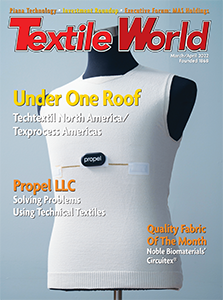The Fiber Factor
A statistical report shows how all three major man-made fibers have been affected by imports
and exports.The Fiber Economics Bureau recently published a statistical series detailing
domestic fiber manufacturer production and shipments, exports, imports and domestic consumption for
三个主要的人造纤维:丙烯酸,尼龙和聚酯。这些数字特别是
揭示纤维进口在美国纺织厂活动中的作用。现代美国纤维行业
is barely 50 years old and has matured dramatically in those few years. Historically, U.S. fiber
生产者是净出口国,而不是因为行业积极追求出口,而是
由于国际竞争对手没有安装技术,因此要求美国纤维
sufficient for competition in critical fabrics.The investment is now in place and enormous
新的纤维进口数量将在未来几年内骚扰国内产业
历史上的所有进口。所有主要纤维都受到影响,但是,正如您可能期望的那样
聚酯是纤维使用的800磅大猩猩,受到最大的影响。
聚酯纤维的消费(灯丝加钉)的年增长率为4.1%
到目前为止,在1990年。
大约38%,而进口量增加了7.67亿磅
(请参阅表1)。
鉴于生产者一直专注于
establishing long-term export programs and the relative economic disadvantages U.S. producers
suffer. Unfortunately, however, imports overwhelmed this success with an average growth of more
在此期间的22%。怪罪亚洲危机及其低价
prices for all of this change this but Table 1 suggests otherwise.From 1990 (admittedly a
在90年代初经济衰退时期相对较低)through 1995 (before the real impact of the Asian
monetary crisis), imports grew at a 27+-percent annual rate. From 1995 through 1998, as the real
亚洲危机的震惊变得显而易见,速度减慢了几乎一半至14%以上的水平
在服装出口服装中使用本国纤维的某种限制。亚洲纤维影响了美国
producers more by slowing non-NAFTA export programs than by ravaging U.S. markets.That is not to
say that current reported prices will help domestic fiber producers but, despite all the wailing,
至少直到1998年,美国聚酯生产商享有相对较好的卷。
domestic and import shipments of polyester staple. Mill consumption of polyester staple increased
by 3+ percent per year for the period but, more importantly, that statistic is of little comfort to
国内生产者。美国制作的美国消费的主食货物并没有在
90年代,作为美国 - 多利特瓶装制造商的平均运输量为21.5亿磅的主食
每年在此期间的国内消费。
1994年(高于1990年衰退水平26%),此后停滞不前,显然受到了
growing flood of manufactured items arriving from Asia.Any growth in U.S. staple consumption since
1991 is accounted for by imports, and it is apparent that domestic producers have abdicated
domestic consumption growth to imports. Starting from the smaller base, imports grew an astounding
29+ percent from 1990 through 1995 and have slowed to a mere 8-percent crawl since. This staple
由于Staple代表
approximately two thirds of all polyester processed in this country.NAFTA is extremely beneficial
for the polyester staple producer. From 97 to 98, polyester staple shipments rose approximately 25
我们的北美自由贸易协定合作伙伴,尤其是墨西哥的百分比,而总体出口货物则增加了
sedate 5 percent.Filament Shipments RiseTable 3 details domestic and import shipments of polyester
纺织丝。与主食的运输和消费模式明显不同,纺织品
filament has enjoyed substantial growth during the 90s.Domestic shipments for domestic consumption
increased from 725 million pounds in 1990 to 1,005 million pounds in 1998, an annual increase of
4.2%,略低于国内聚酯的总发货量4.3%
filament producers.The data shows that while U.S. filament manufacturers had made significant
progress in opening and serving export markets between 1990 and 1996, the bottom dropped out in
1997 and 98 in response to the take-no-prisoners pricing strategies of Asian producers as they
努力在区域金融危机中生存。
规格驱动的聚酯工业纱线业务继续增长。几十年的分析
货物清楚地证明了技术投资的价值。
fiber manufacturers, the industrial market gradually is succumbing to the siren call of lower
priced, generally equivalent quality, imported industrial fibers.Offshore manufacturers are waging
与国内供应商共享一部分工业纺织品的坚定战斗。最近的投资
in state-of-the art spinning and winding equipment will serve Asian producers well in meeting
质量和绩效规格以竞争性的价格高于竞争力。
increases are deliberate manufacturing shifts between NAFTA-sited facilities. But the largest
一部分反映了亚洲国家的活动增加。亚洲人参与世界
市场降低了美国在纺织丝和工业丝市场中的出口机会,
the former dropping by approximately 30 percent from 1996 peaks and the latter, after suffering a
setback in 1996, is now struggling to rise to pre-96 levels. Unfortunately, inexperience and lack
of history in international trade will dog polyester fiber producers for years to come.Changes in
与我们的NAFTA合作伙伴从97到98的聚酯纤维纤维交易完全稳定
那在主食中。加拿大的增加,墨西哥在虚拟对峙的一年中减少了
年份的容量用途,可以从上述分析,国内聚酯纤维中预期
生产商将在未来几年中挣扎,以使运营率高于80%的魔术
级别。我们衡量针对销售(货运)的容量使用,这使我们能够忽略库存
changes which are more financial/production considerations than market driven. Against this
衡量,整个美国聚酯行业在大部分中以80年代中期的运营速度运行
decade and, as we earlier have reported in these pages, the industry was able to maintain finished
在30天范围内的商品库存。进行改进的搜索绳子最终在1998年被打破
U.S. markets faded and plunging Asian domestic consumption dictated export programs in search of
硬货币。整个行业在1998年以74%的运营水平运行
filament suffering the most. As DuPont withdrew Cooper River and part of Kinston from textile
细丝竞争,新的UNIFI能力增加了已经过度施加的行业并开车
60年代中期的纺织细丝操作水平。有趣的是,即使没有进口
textile filament, the operating rate would struggle to rise to 80 percent.The combination of poor
business and recent capacity increases has forced this segment of the industry into the long term
doldrums. Though the players are different (Wellman replaces Unifi), recent operating rates for
polyester staple were barely better than those for textile filament for many of the same reasons.
新容量结合讨价还价的地下室定价进口材料陷入了钉书钉1998年运营
rate to 77 percent, a level only slightly better than that for textile filament.Only the industrial
filament market has expanded sufficiently to absorb both imports and the modestly increased
国内容量。装束和纺织丝都遭受严重的过度容量。很难
在我们看到亚洲恢复的时间比目前显而易见的更多。
1999年5月




